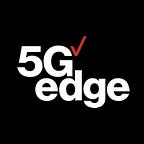re:Invent 2021 Redux: A look back at what you missed.
Robert Belson, Corporate Strategy, Verizon
Christian A. Bergrud, Product Marketing, Verizon
It’s hard to believe it, but AWS re:Invent 2021 happened just over four months ago — but to us, it still feels like yesterday! It’s hard to forget five days of non-stop cloud computing goodness. With over 10,000 attendees and 500+ sessions, perhaps (like us), you too were overwhelmed with the volume of content around all things edge computing.
So we thought we would take you back for a quick look at some of the great things you may have missed on AWS Wavelength and Verizon 5G Edge — from breakout sessions, featured partners, and beyond. So let’s go!
Breakout sessions | Your 4step plan to Mobile Edge Mastery.
1) CMP 209: Harnessing the power of edge computing to innovate
Have you heard about AWS Wavelength and edge computing but are unsure where to start? In this session, you’ll learn more about exactly how Verizon 5G Edge and AWS Wavelength fit into the overall AWS cloud continuum. Additionally, hear how enterprises and startups are taking advantage of AWS Wavelength to deliver new immersive experiences across manufacturing, sports analytics, and beyond.
Button: Watch the session
2) CMP 217-S: Build smarter applications on Verizon 5G Edge with AWS Wavelength (sponsored by Verizon).
Now that you’ve learned more about the edge universe, learn more about the infrastructure fundamentals and what that actually means in terms of applications. After designing your mobile edge architecture, you might find yourself asking the following questions:
● With the proliferation of private MEC (via AWS Outposts) and public MEC (via AWS Wavelength), how do I know the most optimal edge endpoint(s) to deploy my application on Day 1?
● As my mobile device fleet changes over time, how might that affect how I manage and orchestrate my edge environment?
In this session, you’ll learn how a single API, the Edge Discovery Service, can serve as a building block for these ever-complex architectures and how Verizon is building smarter 5G technology at the edge by deploying aerial and ground robots for Industry 4.0 customers.
Button: Watch the session
3) CON321-S: Kubernetes observability use cases (sponsored by New Relic).
Now that we’ve considered the design implications of a multi-edge world, how might we think about Day 2 operations in greater detail? To best harness the performance advantages of the edge, it is critical to instrument these environments and extract critical metrics such as latency, bandwidth, and loss across east-west (e.g., within the cloud) and north-south (e.g., to the cloud) flows, respectively. But without integrated domain knowledge that such edge environments exist, how might these tools provide actionable insights to begin with?
In this session, you’ll learn how the New Relic team is leveraging open-source performance monitoring solutions to differentiate and visualize edge traffic flows using Pixie, Verizon 5G Edge, and AWS Wavelength.
Button: Watch the session
4) CON212-S: Build & deploy applications faster with Red Hat OpenShift Service (sponsored by Red Hat).
The future of Industry 4.0 applications will take advantage of the convergence of two seemingly disparate assets: those within the factory floor and those outside the four walls. What if there was a way to connect intelligent machines over a private network to a fleet of trucks connected over the public commercial network? Such an architecture could usher in a new cloud computing paradigm, from hybrid cloud to hybrid edge.
In this session, you’ll learn from the Red Hat team how OpenShift can reduce the undifferentiated heavy lifting to manage containerized infrastructures and how AWS Wavelength and AWS Outposts — enabled by Verizon 5G Edge — can simultaneously be deployed within a given Kubernetes cluster.
Button: Watch the session
Live demos (The fun stuff).
Elk Audio and the San Francisco Opera bring distributed classical music to life.
Confluent and Hivecell bring real-time data streaming to the edge.
Imagine a moving asset with a need to aggregate sensor information across multiple moving assets in real-time — how might you do so? By connecting sensors on a Raspberry Pi to an MQTT proxy running on a Hivecell server on the moving asset itself, the Hivecell can serve as the 5G-enabled producer of data to the AWS Wavelength Zone. This demo shows how a relative loudness sensor was attached to a Raspberry Pi, streamed to the Hivecell, then streamed to the AWS Wavelength Zone, followed by an aggregation back to the Confluent Cloud in the parent region with a live time-series Grafana dashboard.
Check out the demo live by visiting Confluent’s breakout session here.
Live Niantic demo from Verizon booth.
How might you deliver a real-time multiplayer AR experience without the undifferentiated heavy lifting of open-source frameworks? Mobile devices could compete in a live multiplayer game using Niantic’s Lightship platform on Verizon 5G Edge with AWS Wavelength.
Learn more about the demo by checking out The games that bring our worlds together.
AWS Hands-on Lab (CMP-309).
Are you feeling inspired to build your first application on Verizon 5G Edge with AWS Wavelength? We sure are.
In this hands-on lab, you’ll learn the infrastructure fundamentals of Amazon EKS while deploying a real-world video inference application with best practices across networking, compute, and security. Get started today by using the AWS CLI on your local machine and visiting the demo!
Getting started today.
Don’t fret if you missed any of these great breakout sessions or live demos on AWS Wavelength and Verizon 5G at re:Invent 2021 itself — it’s never too late to get started building on Verizon 5G Edge! Build your first application with us during a live Immersion Day, visit our training courses on Pluralsight, or check out our latest demo apps on GitHub
